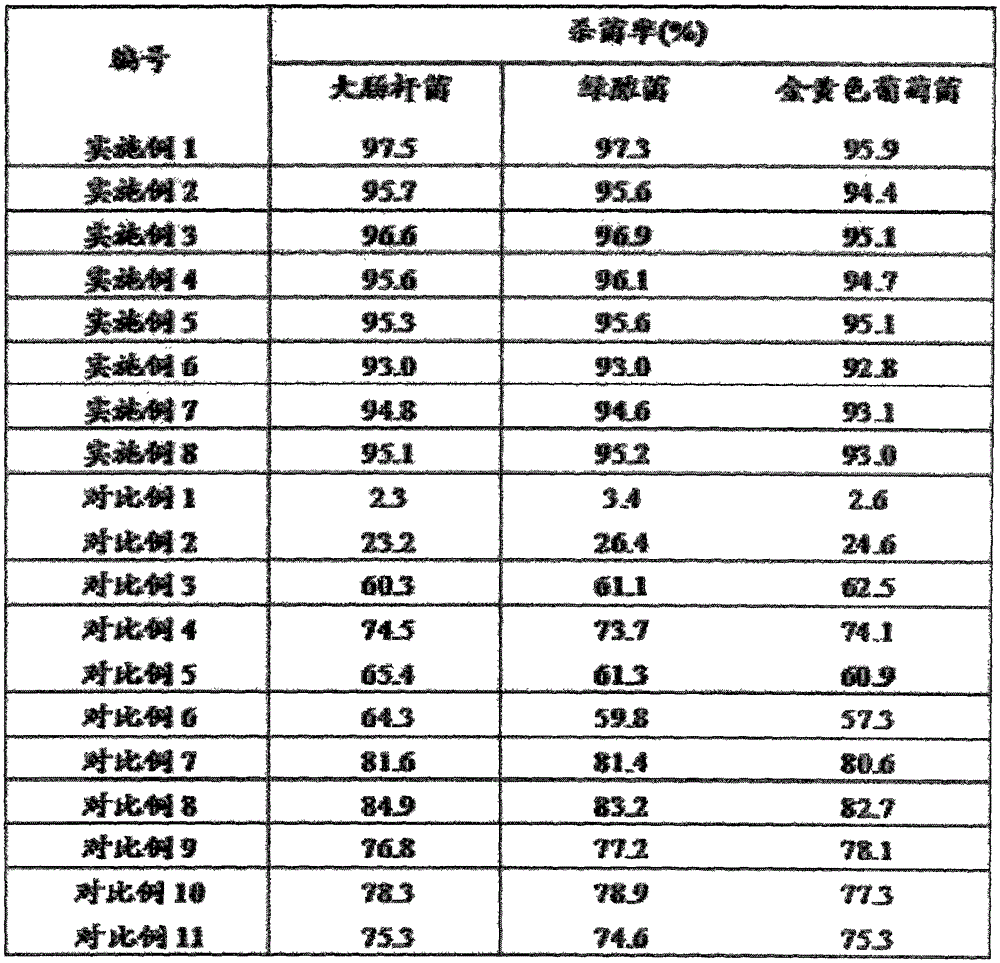Kitchen and bath detergent and preparation method thereof
A cleaning agent, kitchen and bathroom technology, applied in the field of kitchen and bathroom cleaning, can solve the problems of paint surface damage, undisclosed effect results, user's hand discomfort and other problems of kitchen and bathroom utensils, and achieves improved decontamination ability and excellent stability. , Excellent sterilization and disinfection effect
- Summary
- Abstract
- Description
- Claims
- Application Information
AI Technical Summary
Problems solved by technology
Method used
Image
Examples
preparation example 1
[0037] (1) Mix anatase-type titanium dioxide powder with a particle size of 10 nm and urea and stir evenly, then keep at a temperature of 400 ° C for 40 minutes to obtain nitrogen-doped anatase-type titanium dioxide powder, wherein the mass ratio of titanium dioxide to urea is 30:1.
[0038](2) Mix n-octyltrimethoxysilane and the above-mentioned nitrogen-doped anatase titanium dioxide powder with a mass ratio of 1:50 in ethanol with a mass percent concentration of 95% for 2 hours, then centrifuge and wash with acetone 3 times, and then vacuum-dry at 40°C to obtain titanium dioxide powder with a surface-modified silicon oxide layer, which is named SiTiN-1. Tested by transmission electron microscope, the average particle size is 12nm.
preparation example 2
[0040] (1) Mix anatase titanium dioxide powder with a particle size of 15nm and urea and stir evenly, then insulate at a temperature of 480° C. for 45 minutes to obtain nitrogen-doped anatase titanium dioxide powder, wherein the mass ratio of titanium dioxide to urea is 50:1.
[0041] (2) n-octyltrimethoxysilane and the above-mentioned nitrogen-doped anatase titanium dioxide powder were mixed and stirred for 5 hours in ethanol with a mass percentage concentration of 95% at a mass ratio of 1:75, then centrifuged, and washed with acetone for 4 hours. times, and then vacuum-dried at 50°C to obtain a titanium dioxide surface-modified with a silicon-oxygen layer, named SiTiN-2. Tested by transmission electron microscope, the average particle size is 17nm.
preparation example 3
[0043] (1) Mix anatase titanium dioxide powder with a particle size of 20nm and urea and stir evenly, then insulate at a temperature of 550° C. for 50 minutes to obtain nitrogen-doped anatase titanium dioxide powder, wherein the mass ratio of titanium dioxide to urea is 65 : 1.
[0044] (2) n-octyltrimethoxysilane and the above-mentioned nitrogen-doped anatase titanium dioxide powder were mixed and stirred for 10 h in ethanol with a mass percentage concentration of 95% at a mass ratio of 1:100, then centrifuged, and washed with acetone for 5 h. times, and then vacuum-dried at 55°C to obtain a titanium dioxide surface-modified with a silicon-oxygen layer, which was named SiTiN-3. Tested by transmission electron microscope, the average particle size is 23nm.
PUM
| Property | Measurement | Unit |
|---|---|---|
| The average particle size | aaaaa | aaaaa |
| The average particle size | aaaaa | aaaaa |
| Specific surface area | aaaaa | aaaaa |
Abstract
Description
Claims
Application Information
 Login to View More
Login to View More - R&D
- Intellectual Property
- Life Sciences
- Materials
- Tech Scout
- Unparalleled Data Quality
- Higher Quality Content
- 60% Fewer Hallucinations
Browse by: Latest US Patents, China's latest patents, Technical Efficacy Thesaurus, Application Domain, Technology Topic, Popular Technical Reports.
© 2025 PatSnap. All rights reserved.Legal|Privacy policy|Modern Slavery Act Transparency Statement|Sitemap|About US| Contact US: help@patsnap.com


